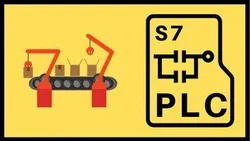
PLC Programming From Scratch To Advance 
This course titled "PLC Programming From Scratch To Advance" will teach you the skills needed to become proficient in S7-PLC programming, regardless of your prior knowledge. The course covers topics such as creating your own logic and making a PLC program from scratch, understanding PLC programming, standard HMI (Human-Machine Interface), creating a variety of ladder logic according to different environments, and learning the difference between digital and analog signals. The course will introduce you to HMI development and provide a general understanding of how an HMI program works. You will also learn to work with multiple software programs to create ladder logic and simulate different environments. ▼
ADVERTISEMENT
Course Feature
![]() Cost:
Cost:
Paid
![]() Provider:
Provider:
Udemy
![]() Certificate:
Certificate:
Paid Certification
![]() Language:
Language:
English
![]() Start Date:
Start Date:
On-Demand
Course Overview
❗The content presented here is sourced directly from Udemy platform. For comprehensive course details, including enrollment information, simply click on the 'Go to class' link on our website.
Updated in [April 24th, 2023]
This course, PLC Programming From Scratch To Advance, is designed to provide students with the basic tools necessary to create a complete PLC program using ladder logic common to most current platforms. Students will learn the difference between digital and analog signals and how to bring them into a PLC, process them, and send them back out. They will also be introduced to HMI development and given a general understanding of how an HMI program works. Through the use of Automation Studio, Factory I/O, and WinSPS S7, students will be able to make variety of ladder logic according to different environments and solve different problems. By the end of the course, students will be able to make their own logic and create a PLC program from scratch.
[Applications]
The application of this course can be seen in various industries such as manufacturing, automotive, aerospace, and robotics. It can be used to create automated systems for controlling machines, processes, and other equipment. It can also be used to create custom logic for controlling various types of equipment. Additionally, it can be used to create custom HMI programs for controlling and monitoring various types of equipment. Furthermore, it can be used to create custom ladder logic for controlling various types of equipment.
[Career Paths]
1. PLC Programmer: PLC Programmers are responsible for creating, testing, and maintaining PLC programs for industrial automation systems. They must have a strong understanding of PLC programming languages, such as Ladder Logic, Structured Text, and Function Block Diagrams. They must also be familiar with the hardware components of the system, such as sensors, actuators, and controllers. The demand for PLC Programmers is increasing as automation systems become more complex and require more sophisticated programming.
2. Automation Engineer: Automation Engineers are responsible for designing, developing, and implementing automation systems. They must have a strong understanding of the principles of automation, such as robotics, machine vision, and motion control. They must also be familiar with the hardware components of the system, such as sensors, actuators, and controllers. Automation Engineers must be able to troubleshoot and debug automation systems, as well as develop and maintain software for the system. The demand for Automation Engineers is increasing as automation systems become more complex and require more sophisticated programming.
3. Control Systems Engineer: Control Systems Engineers are responsible for designing, developing, and implementing control systems for industrial automation systems. They must have a strong understanding of the principles of control systems, such as feedback control, PID control, and fuzzy logic. They must also be familiar with the hardware components of the system, such as sensors, actuators, and controllers. Control Systems Engineers must be able to troubleshoot and debug control systems, as well as develop and maintain software for the system. The demand for Control Systems Engineers is increasing as automation systems become more complex and require more sophisticated programming.
4. Robotics Engineer: Robotics Engineers are responsible for designing, developing, and implementing robotic systems for industrial automation systems. They must have a strong understanding of the principles of robotics, such as kinematics, dynamics, and control. They must also be familiar with the hardware components of the system, such as sensors, actuators, and controllers. Robotics Engineers must be able to troubleshoot and debug robotic systems, as well as develop and maintain software for the system. The demand for Robotics Engineers is increasing as automation systems become more complex and require more sophisticated programming.
[Education Paths]
1. Bachelor of Science in Automation and Robotics: This degree program focuses on the design, development, and implementation of automated systems and robots. It covers topics such as robotics, artificial intelligence, computer vision, and machine learning. Students will learn how to design, build, and program robots and automated systems for various applications. This degree is becoming increasingly popular as automation and robotics technology continues to advance.
2. Master of Science in Automation and Robotics: This degree program builds on the knowledge and skills acquired in the Bachelor of Science in Automation and Robotics. It focuses on advanced topics such as advanced robotics, artificial intelligence, machine learning, and computer vision. Students will learn how to design, build, and program robots and automated systems for various applications. This degree is becoming increasingly popular as automation and robotics technology continues to advance.
3. Doctor of Philosophy in Automation and Robotics: This degree program focuses on the research and development of automated systems and robots. It covers topics such as robotics, artificial intelligence, computer vision, and machine learning. Students will learn how to design, build, and program robots and automated systems for various applications. This degree is becoming increasingly popular as automation and robotics technology continues to advance.
4. Master of Science in Computer Science: This degree program focuses on the design, development, and implementation of computer systems and software. It covers topics such as programming, algorithms, data structures, and computer networks. Students will learn how to design, build, and program computer systems and software for various applications. This degree is becoming increasingly popular as computer science technology continues to advance.
Pros & Cons

Learn keen concepts in PLC programming

Detailed information on PLC programming languages

Step by step approach to learning PLC

Covers logic, timer and counter functions

Includes 3 platforms for PLC programming

Instructor's English is hard to understand

Could use more details in some lessons

A little advanced for starters
Course Provider

Provider Udemy's Stats at AZClass
Discussion and Reviews
0.0 (Based on 0 reviews)
Explore Similar Online Courses

ServiceNow Glide Ajax Tutorial

Regular Expressions in Python

Python for Informatics: Exploring Information

Social Network Analysis

Introduction to Systematic Review and Meta-Analysis

The Analytics Edge

DCO042 - Python For Informatics

Causal Diagrams: Draw Your Assumptions Before Your Conclusions

Whole genome sequencing of bacterial genomes - tools and applications

PLC Memory Organization

PLC: Industrial Sensors

Intro to PLC Programming - FREE
 Related Categories
Related Categories
 Popular Providers
Popular Providers
 Popular Searches
Popular Searches
Quiz
 Submitted Sucessfully
Submitted Sucessfully
1. What is the primary objective of this course?
2. Which software will be used to create ladder logic's and simulate them?
3. What is the main goal of this course?
4. What software will be used in this course?
Correct Answer: Automation Studio, Factory I/O, WinSPS S7


Start your review of PLC Programming From Scratch To Advance